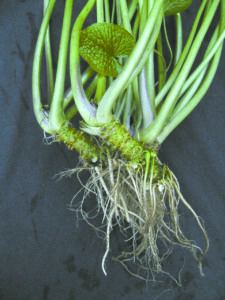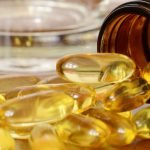A Phytomedical Overview: Wasabia Japonica
Glen Nagel, ND and Brian Oates, PhD
True Japanese Wasabi is one of the world’s most rare perennial crops. Wasabia japonica is a member of the mustard family called the Brassicaceae, formerly Cruciferae. Wasabia is native to Japan and Sakhalin Island north of Japan. It grows naturally in the gravel beds of mountain streams and requires a specific environment to thrive. Wasabia is traditionally cultivated in either water or soil for different tastes. Outside of Japan, Wasabi is usually identified as the spicy green paste served with sushi. However, typical Wasabi paste is in fact horseradish root (Armoracia rusticana) and coloring, and has little if any true Wasabia root. Pure Wasabi (called Wasabia to differentiate it from common horseradish sushi wasabi) is more costly and considered a rare delicacy. It is traditionally grated fresh onto food, since it can lose its flavor in as little as 10-15 minutes. In Japan, Wasabia has not only been considered a food delicacy that adds a pungent flavor to food, but it is also believed to have powerful medicinal action. Like many aspects of a healthy traditional Japanese diet, regular use of Wasabia may be partially responsible for the longevity and health of the Japanese people. Currently, scientific research is beginning to help us understand why Wasabia is both a super food and a powerful herbal medicine.
 Fresh Wasabia contains protein, fiber, vitamins B6 and C, and the minerals calcium, magnesium, potassium and manganese. Wasabia is similar to many plants in the mustard family in that it contains a group of compounds called glucosinolates. These components are enzymatically converted to the bioactive isothiocyanates (ITCs) in an aqueous medium when the cells are disrupted by being chewed or ground up. Wasabia differs from other crucifers in that it has higher concentrations of ITCs, especially long-chain ITCs. These long-chain ITCs (6-methylsulfinylhexyl isothiocyanate or 6-MITC, 7-methylsulfinylheptyl isothiocyanate and 8-methylsulfinyloctyl isothiocyanate) also give Wasabia its unique flavor, termed its “green note.” The enzyme responsible for converting the inert glucosinolates to ITC is myrosinase, a very labile molecule. If Wasabia is air-dried, its myrosinase breaks down; therefore, the ITCs that produce the characteristic heat, flavor and biomedical activity of Wasabia are not formed. This is why traditionally only fresh rhizomes and leaves are used. Now researchers are finding that freeze-drying Wasabia will stabilize the activity of the myrosinase until exposed to water or digestive fluids.
Fresh Wasabia contains protein, fiber, vitamins B6 and C, and the minerals calcium, magnesium, potassium and manganese. Wasabia is similar to many plants in the mustard family in that it contains a group of compounds called glucosinolates. These components are enzymatically converted to the bioactive isothiocyanates (ITCs) in an aqueous medium when the cells are disrupted by being chewed or ground up. Wasabia differs from other crucifers in that it has higher concentrations of ITCs, especially long-chain ITCs. These long-chain ITCs (6-methylsulfinylhexyl isothiocyanate or 6-MITC, 7-methylsulfinylheptyl isothiocyanate and 8-methylsulfinyloctyl isothiocyanate) also give Wasabia its unique flavor, termed its “green note.” The enzyme responsible for converting the inert glucosinolates to ITC is myrosinase, a very labile molecule. If Wasabia is air-dried, its myrosinase breaks down; therefore, the ITCs that produce the characteristic heat, flavor and biomedical activity of Wasabia are not formed. This is why traditionally only fresh rhizomes and leaves are used. Now researchers are finding that freeze-drying Wasabia will stabilize the activity of the myrosinase until exposed to water or digestive fluids.
There is a tremendous amount of ongoing research, especially in Asian countries, on Wasabia and its medicinal benefits. Current findings center on the ITCs that provide the majority of activity. Many scientists have focused on 6-MITC, of which Wasabia japonica contains a high concentration. However, all of Wasabia’s many ITCs (20 or more) likely contribute to the medicinal action. Combined with traditional knowledge, research on Wasabia japonica is providing insight into the actions of Wasabia in the body. Scientific evidence suggests many biomedical applications for the natural components found in Wasabia. The following is a research summary of Wasabia japonica and its ITCs.
Anti-Inflammatory Effects
Wasabia may be useful for controlling seasonal allergies and asthma. ITCs are effective agents for inflammation based on their rapid action and the low levels needed. 6-MITC can inhibit lipoxygenase, cyclooxygenase and cAMP phosphodiesterases that are involved in inflammation. Isothiocyanates of Wasabia and other crucifers are anti-inflammatory (Depree et al., 1998) and anti-asthmatic (Dorsch et al., 1984) agents. Depree et al. (1998) were so impressed with results when testing ITCs that they made the following statements: “The anti-inflammatory effects and inhibition of platelet aggregation by omega-methylthioalkyl isothiocyanates is perhaps of more interest given the rapid action of the compounds and the low levels at which they are effective.” This could potentially be used to counter inflammatory conditions such as allergies, asthma, eczema or even anaphylaxis. The ability of the Wasabia isothiocyanates to inhibit platelet aggregation could also have medical applications, particularly in the treatment of heart attacks. Further work on the pharmacology of these compounds and their possible medicinal use, as well as other medicinal properties of Wasabia, seems warranted. A growing experience from natural health practitioners suggests that Wasabia can be an effective treatment for seasonal allergies as well as asthma and eczema.
Anti-Microbial Effects
ITCs have an inhibitory effect on several strains of bacteria, yeast and mold. In fact, Wasabia japonica was first introduced into the raw fish diet of the Japanese for its anti-microbial properties. Isothiocyanate vapors inhibit the growth of several strains of bacteria, yeast and mold (Depree et al., 1998). Several scientific studies (Ono et al., 1998; Shin and Lee, 1999) have shown that 6-MITC from Wasabia extracts have potent anti-bacterial properties against Staphylococcus aureus and Escherichia coli. Isothiocyanates in Wasabia have demonstrated an inhibitory effect against Streptococcus mutans, the bacterium responsible for dental cavities (Masuda et al., 2000). These results may lead to Wasabia extracts being used in a variety of products (i.e., toothpastes and mouthwashes) for cavity prevention. More recent research has proven Wasabia extracts inhibit mutant strains of the Staphylococcus. Another biomedically important bacterium that Wasabia and ITCs inhibit is Helicobacter pylori (Masuda et al., 2001; Shin et al., 2004; Haristoy et al., 2005). This bacterium is known to be responsible for gastric ulcers and ensuing stomach cancers. Wasabia extracts kill the bacterium, even if it has entered cells lining the stomach.
Anti-Platelet Effects
The inhibition of inappropriate platelet aggregation is important for protection against heart attacks and strokes. The 6-MITC of Wasabia has been found to inhibit platelet aggregation (Kumagai et al., 1994; Morimitsu et al., 2000; Morimitsu et al., 2002), a property useful in the elderly, where preventing excessive clotting is vital. Platelet aggregation is a precipitating factor in cardiovascular diseases. 6-MITC inhibits platelet aggregation by a number of different mechanisms, including the inhibition of lipoxygenase, cyclooxygenase, cAMP phosopodiesterases and cGMP phosphodiesterase.
Anti-Cancer Effects
There is a growing base of evidence on how ITCs work against cancerous cells. Isothiocyanates act to inhibit enzymes that cause pre-carcinogenic compounds to turn into carcinogenic ones (Phase I enzymes).They also can induce detoxifying Phase II enzymes (Yu et al., 1996; Hecht, 1999; Kirlin et al., 1999), like glutathione S-transferase (Morimitsu et al., 2000), possibly through gene expression (Yu et al., 1996; Gao and Talalay, 2004), and inhibit initiation of cancerous growths (Yano et al., 2000). 6-MITC has also been shown to block the cell cycle of cancerous cells (Hashimoto et al., 2004) and to affect protein production in cancerous cells (Hou et al., 2000). Metastasis, a critical stage in spreading cancer beyond local extension, can be blocked by ITCs and in particular 6-MITC. Fuke and her co-workers (1997, 2000, 2006) and Manesh and Kuttan (2003) have shown that 6-MITC from Wasabia suppressed dissemination or metastasis of certain tumor cells. In numerous cases, the ITCs from Wasabia have been shown to cause cancerous cells to undergo apoptosis or cell death. This has been shown in leukemia cells (Nakamura et al., 2001; Fimognari et al., 2004), breast cancer cells (Nomura et al., 2005), lung cancer (Kuang and Chen, 2004), colorectal cancer (Lund et al., 2001) and cancerous cells of other types (Watanabe et al., 2003; Fimognari et al., 2005).
An important point is that ITCs are efficacious against the cancerous cells but do no harm to healthy cells. No side effects have been encountered! Musk and co-workers (1993, 1995) showed that allyl isothiocyanates (AITC), another ITC in Wasabia, was selectively toxic toward colorectal tumor cells. Nakamura et al. (2001) found in the case of leukemia that the ITCs from Wasabia inhibit the growth of leukemia cells but do not inhibit normal cells.
Other Health Effects
In addition to the above health benefits, there is now evidence showing that Wasabia and its isothiocyanates provide other medical effects: It reduces diarrhea (Nakayama et al., 1998); protects nephrons in diabetes patients (Fukuchi et al., 2004); acts as antioxidants (Gao et al., 2001; Lee et al., n.d.); provides immune modulation (Manesh and Kuttan, 2003); inhibits cancer and lessens treatment toxicities (Manesh and Kuttan, 2005); and protects cardiovascular function (Wu et al., 2004).
Wasabia japonica contains another potentially exciting compound. Suzuki and his co-authors (Suzuki et al., 1997; Suzuki and Yamaguchi, 1999) found that a compound in Wasabia japonica leaf stalk extract has a significant stimulatory effect on bone calcification in vitro and in vivo. The authors’ findings revealed that the compound was easily extracted from the plant tissue, is of small molecular weight and functions at low concentrations.
It is likely that Wasabia will become a useful adjunct for many of the chronic health conditions that plague our world. These include asthma, seasonal allergies, arthritis, IBS, Crohn’s disease, allergic reactions, food poisoning, dental carries, gingivitis, H. pylori-caused infection and ulcers, heart disease, stroke, blood clots, protection against certain cancers (breast, prostate, colon, lung, pancreas, esophagus, bladder, leukemia and more), toxicity from chemotherapy and radiation treatment, and osteoporosis. Hopefully, Wasabia and the ITCs found in the whole plant will eventually prove effective against diseases that kill millions of people yearly, like heart disease, cancer, chronic inflammatory diseases and infections. Recent advances in herbal processing have made the active glucosinolates in Wasabia stable until mixed with digestive juices, allowing the full spectrum of fresh Wasabia rhizome ITCs to be available. This is indeed an exciting time to be discovering the ancient wisdom of medicinal plants. Wasabia has a long traditional use in the East and the potential to become a useful food, supplement and/or medicine for the rest of the world.
 Glen Nagel, ND has been a practicing herbalist for the last 20 years. He has worked in the herbal industry and as an herbal educator, offering classes and courses in herbal medicine. Nagel is also a licensed ND in Washington and Oregon, and has practiced naturopathic medicine since 1993. He is a former assistant professor of botanical medicine at Bastyr University. Currently, Nagel works as a clinical supervisor at NCNM and as a director of education for Eclectic Institute Inc.
Glen Nagel, ND has been a practicing herbalist for the last 20 years. He has worked in the herbal industry and as an herbal educator, offering classes and courses in herbal medicine. Nagel is also a licensed ND in Washington and Oregon, and has practiced naturopathic medicine since 1993. He is a former assistant professor of botanical medicine at Bastyr University. Currently, Nagel works as a clinical supervisor at NCNM and as a director of education for Eclectic Institute Inc.
Brian Oates, PhD is the founder and president of Pacific Coast Wasabi (PCW). Oates became interested in Wasabia japonica after uncovering the abundant biomedical efficacies of this plant. Prior to starting up PCW, Oates was a research scientist and lecturer for 15 years in the department of botany at the University of British Columbia. He has acted as a consultant for several companies, developing new biologically based products. Dr Oates is a graduate of the University of California, Irvine.
References
Depree JA et al: Flavour and pharmaceutical properties of the volatile sulphur compounds of Wasabi (Wasabia japonica), Food Res Intern 31:329-337, 1998.
Dorsch W et al: Antiasthmatic effects of onion extracts–detection of benzyl- and other isothiocyanates (mustard oils) as antiasthmatic compounds of plant origin, Eur J Pharmacol 107:17-24, 1984.
Fimognari C et al: A mixture of isothiocyanates induces cyclin B1- and p53-mediated cell-cycle arrest and apoptosis of human T lymphoblastoid cells, Mutat Res 554:205-214, 2004.
Fimognari C et al: Micronucleus formation and induction of apoptosis by different isothiocyanates and a mixture of isothiocyanates in human lymphocyte cultures, Mutation Research 582:1-10, 2005.
Fuke Y et al: Anti-carcinogenic activity of 6-methylsulfinylhexyl isothiocyanate, an active anti-proliferative principal of wasabi (Eutrema wasabi Maxim.), Cytotechnology 25:197-203, 1997.
Fuke Y et al: Suppressive effect on tumor metastasis by 6-(methylsulfinyl)hexyl isothiocyanates from Wasabi, Nippon Shokuhin Kagaku Kogaku Kaishi 47:760-766, 2000.
Fuke Y et al: Preventive effect of oral administration of 6-(methylsulfinyl)hexyl isothiocyanate derived from wasabi (Wasabia japonica Matsum) against pulmonary metastasis of B16-BL6 mouse melanoma cells, Cancer Detect Prev 30:174-179, 2006.
Fukuchi Y et al: 6-Methylsulfinylhexyl isothiocyanate, an antioxidant derived from Wasabia japonica MATUM,ameliorates diabetic nephropathy in Type 2 diabetic mice, Food Sci Technol Res 10: 290-295, 2004.
Gao X and Talalay P: Induction of phase 2 genes by sulforaphane protects retinal pigment epithelial cells against photooxidative damage, Proc Nat Acad Sci USA 101:10446-10451, 2004.
Gao X et al: Powerful and prolonged protection of human retinal pigment epithelial cells, keratinocytes, and mouse leukemia cells against oxidative damage: The indirect antioxidant effects of sulforaphane, Proc Nat Acad Sci 98:15221-15226, 2001.
Hashimoto T et al: 6-Methylsulfinylhexyl Isothiocyanate Inhibits Cell Cycle Progression in Mouse Epidermal JB6 Cells, Dietary Factors and Cancer Prevention, 9, 2004.
Haristoy X et al: Evaluation of the antimicrobial effects of several isothiocyanates on Helicobacter pylori, Planta Med 71:326-330, 2005.
Hecht S: Chemoprevention of cancer by isothiocyanates, modifiers of carcinogen metabolism, J Nutr 129: 768S-774S, 1999.Hou D et al: Transcriptional regulation of nicotinamide adenine dinucleotide phosphate: quinone oxidoreductase in murine hepatoma cells by 6-(methylsufinyl)hexyl isothiocyanate, an active principle of wasabi (Eutrema wasabi Maxim), Cancer Lett 161:195-200, 2000.
Kirlin W et al: Dietary compounds that induce cancer preventative phase 2 enzymes activate apoptosis at comparable doses in HT29 colon carcinoma cells, J Nutr 129:1827-35, 1999.
Kuang Y and Chen Y: Induction of apoptosis in a non-small cell human lung cancer cell line by isothiocyanates is associated with P53 and P21, Food Chem Toxicol 42:1711-1718, 2004.
Kumagai H et al: Analysis of volatile components in essential oil of upland Wasabi and their inhibitory effects on platelet aggregation, Bioscience Biotechnology and Biochemistry 58:2131-2135, 1994.
Lee Y et al: Anti-oxidant activities of Wasabia japonica extracts in vitro and Anti-hypercholesterolemic effects of Wasabia japonica diet in hypercholesterolemia rats, European Journal of Pharmacology (Submitted January 2005).
Lund E et al: Cell death in the colorectal cancer cell line HT29 in response to glucosinolate metabolites, J Sci Food and Agric 81: 959-961, 2001.
Manesh C and Kuttan G: Effect of naturally occurring isothiocyanates on the immune system, Immunopharmacol Immunotoxicol, 25:451-459, 2003.
Manesh E and Kuttan G: Effect of naturally occurring isothiocyanates in the inhibition of cyclophosphamide-induced urotoxicity, Phytomedicine 12:487-493, 2005.
Masuda H et al: Comparison of inhibitory effect of sawa-Wasabi (Wasabia japonica) on the growth of Helicobacter pylori, American Chemical Society Annual Meeting, 2001.
Morimitsu Y et al: Antiplatelet and anticancer isothiocyanates in Japanese domestic horseradish, Wasabi, Biofactors 13:271-276, 2000.
Morimitsu K et al: A sulforaphane analogue that potently activates the Nrf2-dependent detoxification pathway, J Biol Chem 277: 3456-63, 2002.
Musk SR and Johnson IT: Allyl isothiocyanate is selectively toxic to transformed cells of the human colorectal tumor line HT29, Carcinogenesis 14:2079-2083, 1993.
Musk SR et al: Selective toxicity of compounds naturally present in food toward the transformed phenotype of human colorectal cell line HT29, Nutr Cancer 24: 289-98, 1995.
Nakamura O: Wasabi-derived isothiocyanate derivative, 6-(methysulfinyl) hexyl isothiocyanate, kills human leukemic cells inducing apoptosis, Mutation Research 483:S109, 2001.
Nakayama H et al: Effect of Wasabi on ion secretion in guinea pig colon, Nippon Nogeikagaku Kaisha 72:499-507, 1998.
Nomura T et al: Selective sensitivity to wasabi-derived 6-(methylsulfinyl)hexyl isothiocyanate of human breast cancer and melanoma cell lines studied in vitro, Cancer Detect Prev 29:155-60, 2005.
Ono H et al: 6-Methylsulfinylhexyl isothiocyanate and its homologues as food-originated compounds with antibacterial activity against Escherichia coli and Staphylococcus aureus, Biosci Biotechnol Biochem 62: 363-5, 1998.
Shin IS and Lee JM: Study on antimicrobial and antimutagenic activity of horseradish (Wasabia japonica) root extracts, Bulletin of the Korean Fisheries Society, 31:835841, 1998.
Shin I et al: Bactericidal activity of wasabi (Wasabia japonica) against Helicobacter pylori, Int J Food Microbiol 94:255-261, 2004.
Suzuki T et al: Effect of Wasabi leafstalk (Wasabia japonica Matsum) extract on bone metabolism in mouse calvaria tissue culture, Food Science Technology Research 3:366-369, 1997.
Suzuki T and Yamaguchi M: Anabolic effect of Wasabi leafstalk (Wasabia japonica Matsum) extract on bone metabolism in rat, Food Science Technology Research 5: 61-63, 1999.
Watanabe M et al: Identification of 6-methylsulfinylhexyl isothiocyanate as an apoptosis-inducing component in wasabi, Phytochemistry 62:733-739, 2003.
Wu L et al: Dietary approach to attenuate oxidative stress, hypertension, and inflammation in the cardiovascular system, Proc Nat Acad Sci 101:7094-7099, 2004.
Yano Tet al: The effect of 6-methylthiohexyl isothiocyanate isolated from Wasabia japonica (wasabi) on 4-(methylnitrosamino)-1-(3-pyridyl)-1-butanone-induced lung tumorigenesis in mice, Cancer Lett 155:115-120, 2000.
Yu R et al: Phenethyl isothiocyanate, a natural chemopreventive agent, activates c-Jun N-terminal kinase 1, Cancer Res 56:2954-2959, 1996.










